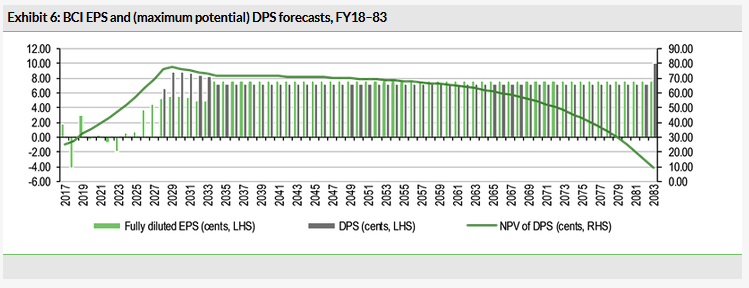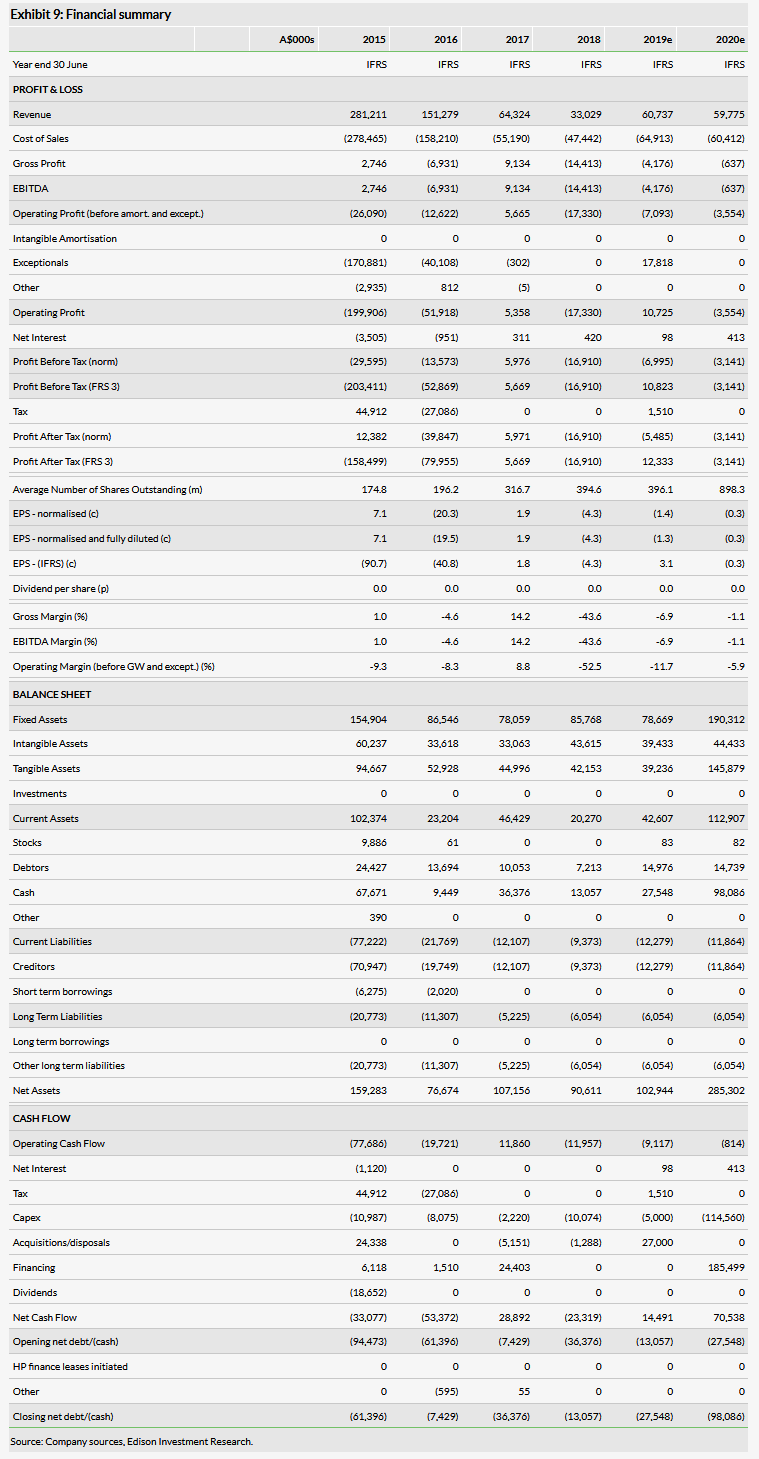On 17 May BCI announced the results of its PFS optimisation study at its Mardie salt and potash project in north-western Australia. Relative to its earlier PFS study (the results of which were announced in June 2018), the principal differences are an increase in salt and sulphate of potash (SOP) production, by 14.3% and 33.3% respectively, and the development of a dedicated port at the Mardie site. While this has increased the project’s capex estimate by 48.7% to A$498m, it has increased its pre-tax NPV10 by 67.2% and our estimate of post-tax NPV10 by A$111.2m to A$345.5m (or 86.9c per existing BCI share). At the same time, the project’s operational lifespan has been extended to 60 years (from 30 years previously).

Mardie stand-alone valuation increases to 9.76cps
In our report Gold stars and Black holes: Analysing the discount: From resource to sanction, published in January 2019, we observed that, excluding outliers, the average valuation of companies at PFS stage is 9.9% of attributable NPV. On this basis (and assuming a post-tax NPV of 70% of pre-tax NPV of A$560m), an average valuation for Mardie would be A$38.8m, or 9.76 cents per share. However, if the DFS on Mardie, which is underway, is completed on approximately the same terms, we would expect this valuation to increase more than threefold, to c 30.9% of NPV, or 30.46c per share. This excludes the 19.51c at which we valued BCI’s other operating assets in our Outlook report, BCI Minerals: Salt plus potash plus iron equals value, published on 7 February 2019. It also excludes the 2.43c value of BCI’s other non-operating assets – ie Buckland (see BCI Minerals: Increasing iron ore royalties supporting Mardie, published on 16 April 2019).
Initiative broadens funding options
One additional consequence of its plans to develop a dedicated port at Mardie could be that BCI’s potential for concessional debt funding via Australia’s federal North Australia Infrastructure Facility (NAIF) is increased.
Valuation: Still almost 2x share price
In the wake of its quarterly activities report, we value the stream of dividends payable to BCI shareholders from Iron Valley and the development of Mardie at 35.13c (cf 31.62 previously). To this should be added a further 2.43c for its Buckland assets to take the total to 37.56c. Further upside then exists if iron ore prices remain at elevated levels beyond June and/or the Australian dollar remains at its currently depressed levels.

Business description
BCI Minerals has two major assets in Western Australia, including a 100% interest in the Mardie salt and potash project and a royalty-type interest in the Iron Valley iron ore mine operated by Mineral Resources. It also has exploration tenements in iron ore and other minerals.
Mardie PFS optimisation
BCI is preparing a DFS for its Mardie salt and SOP project, which it expects to be completed in the final quarter of calendar year 2019. As part of the process, it has been investigating a number of optimisation opportunities relative to its PFS, which it has incorporated into the development case and compiled in a separate PFS optimisation study, the results of which are summarised in Exhibit 1. The main differences between the PFS and the PFS optimisation study are an increase in salt and SOP production by 14.3% and 33.3%, respectively, and the development of a dedicated export facility at the Mardie site (as opposed to trucking output to either Cape Preston East Port or the Dampier general cargo wharf for export).

Operational and capital cost estimates for the purposes of the PFS optimisation study were undertaken to an accuracy of ±25% (cf -15% to +25% for the PFS), qualifying it as an AACE Class 4 estimate (as before), as defined under Association for the Advancement of Cost Engineering Recommended Practice Number 18R-97 (ie a pre-feasibility study). In the meantime, Mardie’s projected operational life of 60 years is predicated upon the grant of a mining licence for 21 years plus two extensions (3 × 21 = 63) minus three years for construction.
Capex
To achieve the increase in production, BCI and its independent experts increased the project footprint layout to 79km2 for the concentrator ponds and 20km2 for the crystallisers. Both of these increased parameters were factored into the Environmental Review Document submitted to the Environmental Protection Agency (EPA) in April this year.
As a result, total capex for the Mardie project is now estimated to be A$498m (cf A$335m previously), comprising A$401m for the salt production circuit and port and A$97m for the SOP production circuit, with almost all of the increase accounted for by the inclusion of the Mardie port into the new project scope.

The Mardie Port will comprise a trestle jetty with a conveyor (or light rail) and road, designed to traverse the intertidal zone for c 3km before extending into the ocean for a further 3.5km to reach ship loading infrastructure and a transhipment berth pocket. Salt will be conveyed in bulk form to the end of the jetty before being loaded onto transhipment vessels via a ship loader and transhipped to ocean going vessels anchored c 15 nautical miles (17 miles or 28km) offshore. SOP will be exported in a similar manner, albeit via a crane onto smaller vessels and packaged in bulka bags (that typically measure 90cm × 90cm × 120cm).
BCI’s contracting strategy is designed to ensure it has adequate control over key production processes, but that non-production activities (eg accommodation, power supply, etc) are contracted out. Consequently, these are excluded from Mardie’s capital cost estimate but are included in its opex estimate (below).
Opex
The main consequence of developing a dedicated port at the Mardie site is that it obviates road haulage costs, as shown in the updated schedule of operating costs reproduced below:

Note that operating cost estimates have been calculated on a free on board (FOB) basis.
Valuation considerations
On the basis of the above assumptions and that the first full years of production are FY24 and FY26 for salt and SOP, respectively, we estimate the following valuations for the project (assuming a 30% standard rate of corporate tax in Australia):

Note that the extent by which our NPV estimates exceed those of the formal studies can largely be explained by its adoption of a (weaker) prevailing forex rate in its calculations.
In our report Gold stars and Black holes: Analysing the discount: From resource to sanction, published in January 2019, we observed that, excluding outliers, the maximum and minimum valuations for companies with projects at different stages of development are as follows (Exhibits 166 and 173 of the original report):

Assuming a post-tax NPV of 70% of pre-tax NPV of A$560m (as per its formal PFS optimisation study), an average valuation for BCI of 9.9% of Mardie’s NPV (excluding its other assets) would be A$38.8m, or 9.76 cents per share (cf A$23.2m, or 5.84cps, previously). If the DFS on Mardie is completed on approximately the same terms, however, we would expect this valuation to increase more than threefold, to c 30.9% of NPV, or 30.46c per share (cf 18.22c/share, previously). Note that this excludes the 19.51c at which we valued BCI’s other operating assets in our Outlook report, BCI Minerals: Salt plus potash plus iron equals value, published on 7 February 2019. It also excludes the 2.43c value of BCI’s other non-operating assets (ie Buckland – see BCI Minerals: Increasing iron ore royalties supporting Mardie, published on 16 April 2019).
In the meantime, BCI has stated that it will advance development funding options for the project in detail during the preparation of the Mardie DFS. Currently, project development capex of A$498m is ‘likely to be funded from a combination of project debt, equity, product offtake pre-commitments and via build-own-operate (or similar) models where feasible.’ However, it has also said it ‘will consider all feasible funding structures for the equity component including raising equity in BCI for investment into the project, or raising direct equity into the project’. In addition, its plans to develop a port at Mardie may attract concessional debt funding via Australia’s federal NAIF.
Edison’s financial model assumes that BCI funds Mardie via equity into the company, in which case we estimate that the company would have to raise A$195.3m (gross) in FY20 (cf c A$100m previously) to maintain a maximum leverage ratio (net debt/[net debt+equity]) of no more than 50% in FY23 when net debt to fund the project would peak at A$273.9m (cf A$191.9m previously) – some of the equity having been provided in the form of retained earnings from income from BCI’s Iron Valley interests. If conducted at the current share price of A$0.195 (cf A$0.16 previously), our long-term estimates of BCI’s earnings (maximum potential), dividends per share and valuation trajectory are then as follows:

Discounting at our customary discount rate of 10% per year, the (fully diluted) value of these cash flows to shareholders is 35.13 Australian cents (cf 31.62c at the time of our update note, BCI Minerals: Increasing iron ore royalties supporting Mardie, published on 16 April 2019) as at 1 July 2018, rising to 38.64c at 1 July 2019. To this should then be added a further 2.43c for its Buckland assets to take the total to 37.56c
Note that our valuation, on this basis, peaks at 80.12 Australian cents in FY28 (cf 70.66c previously), when EPS will be 5.77c (cf 5.43c previously), therefore putting BCI on a contemporary P/E ratio of 13.9x. Self-evidently, this valuation could increase further to the extent that iron ore prices remain at elevated levels beyond June 2019.
Other matters
Politics
Last weekend, Australia concluded a general election in which all 151 seats in the House of Representatives (lower house) and 40 of the 76 seats in the Senate (upper house) were up for election (note that Australia enforces compulsory voting). In yet another upset to the pre-election polls, the incumbent minority coalition government, led by Prime Minister Scott Morrison, won a third three-year term against the Labor (sic) opposition, winning enough seats to form a right-of-centre Liberal majority government in its own right.
Australian interest rates are set by the Reserve Bank of Australia, which is independent. Nevertheless, on the basis of the Liberals’ pre-election manifesto, the new government is expected to pursue economic policies that are consistent with low domestic interest rates to keep the Australian unit of currency weak in order to maintain the competitiveness of its exports – a policy that should align favourably with BCI’s and Mardie’s development initiatives.
Economics
At the same time as the Australian dollar has been weakening in response to political considerations, the prices of both standard grade 62% iron ore and 58% lower grade ore have continued to exhibit material strength and the discount of the latter to the former has continued to narrow.

Our forecasts for BCI for FY19 are predicated on a Q419 58% iron ore price of US$78.54/t, whereas (on current trends) the price actually looks likely to average US$79.46/t, as the shortage of iron ore supply as a result of Brazilian mine shutdowns in the wake of Vale’s tailings dams disasters continues to squeeze prices higher. Self-evidently, the extent to which this trend continues into the future will affect our earnings forecasts and Iron Valley valuation positively, especially into FY20 and beyond.
